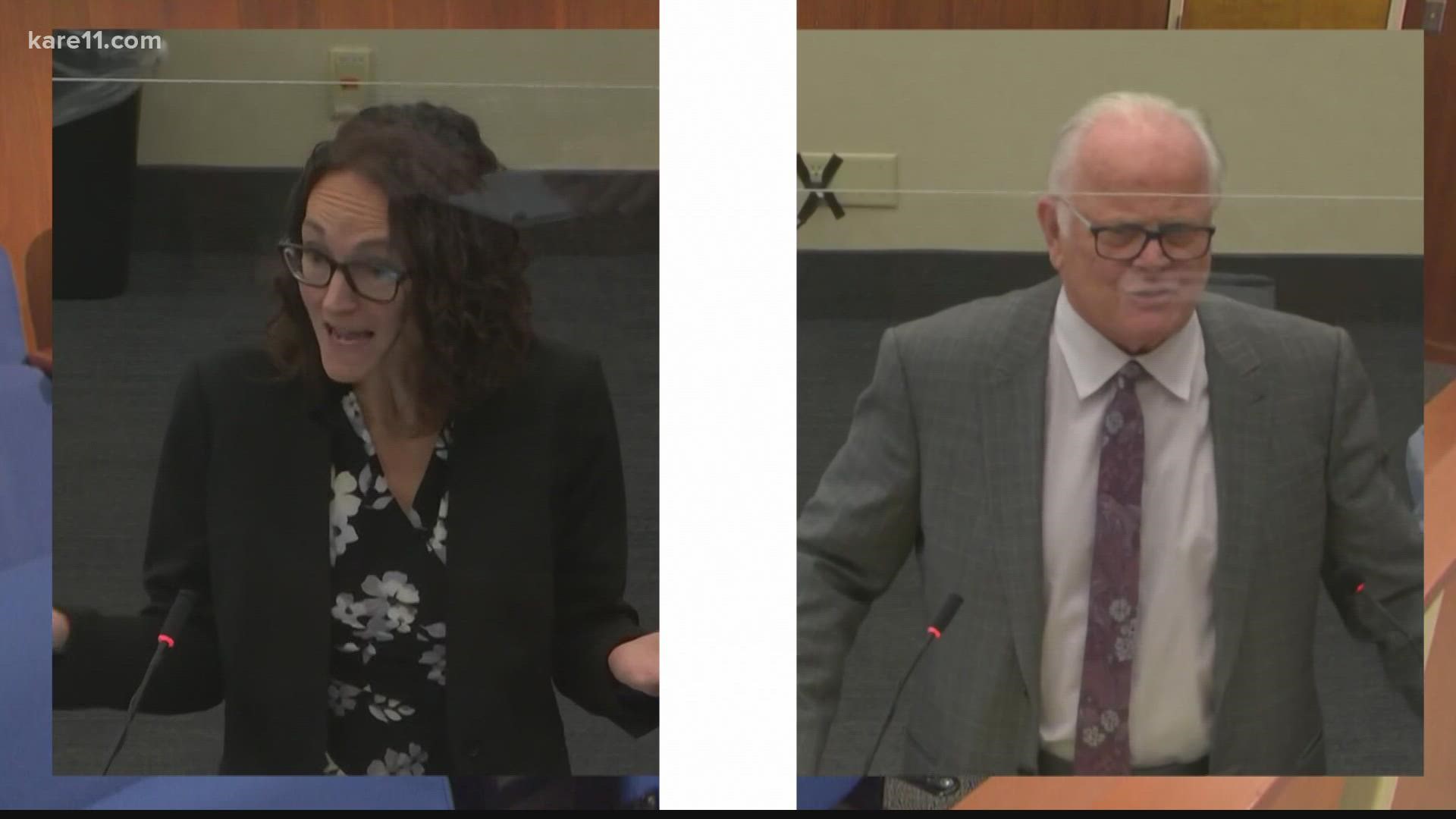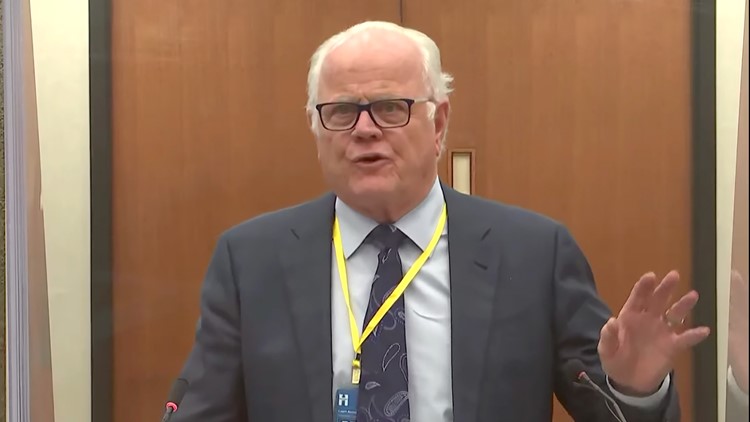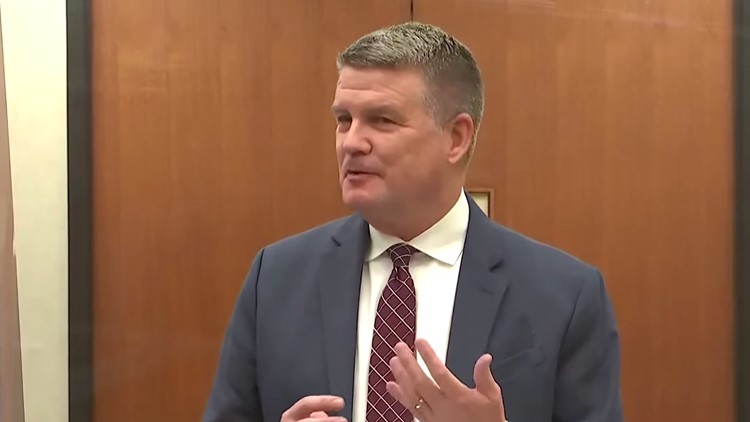MINNEAPOLIS —
- Case sent to jury shortly before 1 p.m. Monday
- Earl Gray delivers closing argument for the defense
- Erin Eldridge, Matthew Frank deliver closing argument and rebuttal for the prosecution
- Judge Regina Chu issues jury instructions
- Kim Potter gave emotional testimony Friday: "I'm sorry it happened"
6 p.m.
Jury deliberations adjourned for the day around 6 p.m. without a verdict. Jurors deliberated for a little more than five hours.
Jurors returned to court briefly in the afternoon to ask a question about the timing of Kim Potter's interview with defense expert Dr. Laurence Miller; however, Judge Chu answered by telling the jury that "all evidence is in" and they must rely on their collective memory" about the evidence.
Jurors are expected to remain sequestered, but will be allowed to have limited electronic contact with family.
1 p.m.
After dismissing the jury, the defense explained several objections it raised during the state's rebuttal, calling for a mistrial. Judge Chu denied the motion.
The jury will deliberate on Monday until 6 p.m.
12:45 p.m.
Matthew Frank delivered the state’s rebuttal to the defense’s closing argument.
Frank struck back against the defense’s mention of Potter making a “mistake.” He said whether it was a mistake or not should have no bearing on the jury’s decision because there is no “mistake defense,” and that Judge Chu will not give instruction on finding a person not guilty if they make a mistake.
He also responded to the defense’s argument that Potter could not be found to be using her firearm recklessly because she didn’t know she was using it in the first place. Frank said that lack of knowledge is exactly why it was reckless.
“How can you recklessly handle a firearm? That’s exactly the point,” Frank said. “She pulled her handgun instead of her Taser. That’s recklessly handling a firearm, that’s how.”
Frank said the state only needs to prove that Potter was aware of the risk of using a gun, not that there was a gun in her hand. He said despite the defense’s argument that Potter was not conscious that she was holding her gun, the conscious acts Potter took were reaching for her gun holster, drawing her gun and pulling the trigger.
“She was aware of the risk of drawing a gun instead of the Taser,” he said. “… She still used her right hand to pull the gun instead of her left hand to pull her Taser, did not even look to see if it was her Taser and pulled the trigger a foot or two from Daunte Wright’s chest.”
Frank emphasized that the jury is not being asked to consider whether using a Taser on Wright would have been a reasonable use of force, because that is not ultimately what happened. He said the jury must weigh whether the use of deadly force with a firearm was reasonable.
He said Potter did not even believe deadly force was necessary, because the evidence shows she intended to use her Taser. He referenced what Potter said before the shooting, calling out, “Taser, Taser, Taser,” as well as what she said after, when she said she “used the wrong gun.”
“Is that the reaction of somebody who thought deadly force is really necessary?” Frank asked. “Also important is what she did not say. She never said, ‘I had to shoot him, or somebody else could have gotten hurt.’ … If she didn’t believe deadly force was necessary, how could a reasonable officer in that position believe it?”
Frank added that Wright trying to resist arrest cannot be a superseding cause because it began before Potter shot him, not after.
Frank also said the defense’s argument that Wright caused his own death is “somewhat stunning.” He said it was an effort by the defense to "rebrand" the case and called the argument both factually and legally wrong.
He said if we accept that Wright caused his own death, “we have to accept that if someone doesn’t follow the commands of an officer, they can cause their own death.” Frank called that argument “absurd.”
“Officers still have to use reasonable force in apprehending a person,” he said.
After the state’s rebuttal, Judge Chu gave final jury instructions and dismissed the two alternates on the jury panel.
Shortly before 1 p.m. on Monday, Judge Chu sent the case to the jury to begin deliberations.
11:45 a.m.
Defense attorney Earl Gray began his closing argument by responding to an accusation from the state that the defense would try “run (the jury) down a rabbit of misdirection.”
He said the state did that in its closing argument by showing the video of the shooting frame-by-frame, and asked the jury to review the footage in real time while deliberating to see the “chaos” of those moments.
Gray also reminded the jury that their duty is to presume Potter is innocent, and that the state bears the burden of proof. He brought up language in the jury instructions, specifically the portion that says Potter cannot be found criminally liable if a “superseding cause,” something that happened after the defendant’s actions, causes the death.
Gray argued that by resisting arrest and trying to flee, Wright created that superseding cause.
“That’s what caused this whole incident,” Gray said. “If he would have gone and went with the officers, been handcuffed, go to the squad car, go take a ride downtown, it would have been over.”
Gray also emphasized that Potter was authorized to use deadly force during the arrest, reminding the jury of testimony from former Brooklyn Center Police Chief Tim Gannon, who said on the stand that he believed Potter’s use of a firearm was appropriate.
However, Gray said that Potter did not know she was using a gun, and therefore could not be convicted of first-degree manslaughter. He referred to the charge’s definition of “reckless,” which includes the words “conscious or intentional.” Gray said the evidence shows Potter did not know she was using a gun when she shot Wright, so her behavior could not have been conscious.
“Everybody makes mistakes, this lady here made a mistake, and my gosh, a mistake is not a crime,” Gray said “It just isn’t in our freedom-loving country, that we’re going to put you in jail for a mistake you made.”
He also referenced character testimony from Potter’s fellow officers, who he said called her a “peaceful person” who has never been accused of being a "bully cop" in 26 years of policing.
Gray concluded by asking the jury to find Potter not guilty.
“If you look at the evidence and follow judge’s instructions, it’s not a difficult case,” he said. “They failed in every element, miserably failed. I hope you come to fair conclusion of not guilty based on the evidence.”
10:30 a.m.
Prosecutor Erin Eldridge delivered closing arguments on behalf of the state. She opened by saying that Daunte Wright’s family will have an empty seat at their table this Christmas. “At the heart of it, this case is very simple,” she said. “It’s a case about the defendant’s reckless handling of her firearm and it’s about her culpable negligence.” Eldridge doubled down on the point argued during witness testimony that Potter had decades of experience and firearms training, and that she was up to date on the most recent policies for the Brooklyn Center Police Department. “This case is about the defendant’s rash and reckless conduct,” she said.
Eldridge walked through video of Daunte Wright’s shooting frame by frame, pointing out how close her gun was to Officer Luckey’s face when she pulled the trigger. “Responsible officers know not to blindly draw their weapons and press the trigger,” Eldridge argued, saying they’re “acutely aware of the risks of getting it wrong.” Eldridge said that Potter chose to take on the responsibility of becoming a police officer, but failed in that responsibility. “She betrayed her badge and she betrayed her oath, she betrayed Daunte Wright and her fellow officers too. And her conduct was criminal.”
Before closing, Eldridge reminded the jury that their job is to come to a decision without sympathy. "This case is not about remorse, it’s about the defendant's actions in shooting and killing Daunte Wright."
9 a.m.
Before the prosecution and defense made their closing arguments, Judge Regina Chu read instructions to the jury. The jury will use those instructions to determine if Kim Potter is guilty or not guilty of first-degree manslaughter and second-degree manslaughter. The prosecution will have had to prove beyond reasonable doubt that Potter is guilty of those charges. Chu defined those charges for the jury under Minnesota law, and the elements required to determine if Potter is guilty of them. For the jury to find Kim Potter guilty of first-degree manslaughter, the prosecution had to prove the following beyond a reasonable doubt:
- The death of Daunte Wright
- The defendant caused the death of Daunte Wright
- Wright’s death was caused by Potter’s committing the crime of reckless handling or use of a firearm
- Potter committed the crime of reckless use or handling of a firearm with such force or violence that the death of another person or great bodily harm was reasonably foreseeable
- Wright’s death took place on April 11, 2021 in Hennepin County
For the jury to find Potter guilty of second-degree manslaughter, the prosecution had to prove the following beyond a reasonable doubt:
- The death of Daunte Wright
- Potter caused the Wright’s death by culpable negligence and created unreasonable risk and consciously took a chance of causing death or great bodily harm
- Wright’s death took place on April 11, 2021 in Hennepin County
Culpable negligence is defined as intentional conduct that the defendant, in this case Kim Potter, may not have intended to be harmful but an ordinary and reasonably prudent person would recognize as involving a strong possibility of injury to others.
The state rested its case on Thursday, Dec. 16. After calling several witnesses on Thursday, including use-of-force expert Stephen Ijames and several character witnesses for Potter, the defense brought out another expert witness on Friday -- Dr. Laurence Miller.
Dr. Miller, a psychologist, author and professor with expertise in clinical, neuro and police psychology, defined for the courtroom the concept of “action errors.” Miller explained that action errors occur when a person “intends to do one thing, think you’re doing it, but do something else and later realize it.”
During cross examination, prosecutor Erin Eldridge wanted to question Miller about an interview he did with Potter after the shooting, but Judge Chu sustained the defense’s objection to do so.
The jury heard from Kim Potter herself on Friday, the final witness for the defense. In emotional testimony, Potter described the "chaotic" moment when Brooklyn Center Officer Anthony Luckey attempted to arrest Daunte Wright.
Potter broke down as she described the ensuing “struggle” and said she remembered yelling, “Taser.”
"And then he told me I shot him," she said as she covered her face and broke into tears.
Eldridge’s cross examination mostly focused on Potter’s training. She showed Potter the BCPD’s Taser training policy, which states all trainings should include practicing drawing one’s Taser. Potter agreed that the purpose of that training was to reduce the risk of accidentally drawing a firearm.
Through tears, Potter said she didn't plan or want to use deadly force.
"I didn't want to hurt anybody," Potter said.
More from the trial of Kim Potter
Watch more cover from the trial of Kim Potter on our YouTube playlist:











